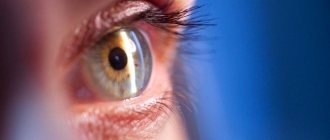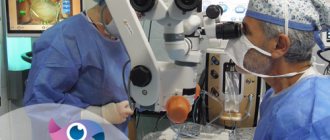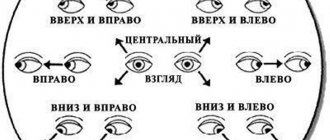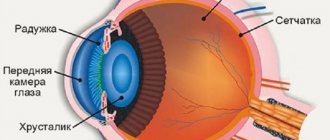Cataracts are a disease that, if left untreated, leads to vision loss. In the CIS countries, lens opacification occupies one of the leading positions in the list of the most common ophthalmological diseases. With cataracts, the vision and quality of life of the sick person as a whole significantly deteriorate, so it is important to start treatment on time and strengthen the visual organs in every possible way, which is greatly helped by proper nutrition and diet for cataracts.
Is it possible to do without cataract surgery?
With cataracts, it is necessary to remember that clouding of the lens does not resolve on its own. At the initial stage, drug treatment is still possible, but the drops only slow down the progression of the pathological process without eliminating the disease.
The only way to treat cataracts is surgery. If you previously resorted to wait-and-see tactics, it is now recommended to perform surgery as soon as possible. This allows you to avoid complications and negative effects on eye function, and also get the maximum from treatment.
Surgical therapy for cataracts is safe and proven. Most often, such operations are performed on an outpatient basis. Many people postpone treatment because they consider any surgical intervention dangerous, that is, a last resort. But for cataracts, surgery is the only effective treatment that cannot be postponed. If for some reason the patient wishes to postpone treatment, it is necessary to support the visual system in every possible way during this period.
Causes, symptoms and types of cataracts
One of the advanced technologies is phacoemulsification. The procedure allows you to remove the lens using ultrasound through a corneal incision of no more than 3 mm. Fragments of destroyed tissue are removed using special microsurgical equipment. An artificial lens, selected individually, is inserted at the site of the removed organ. No stitches are required, as the tissue heals on its own.
The second operation option is extraction. After a 10-12 mm incision, the cataract is removed microsurgically. The procedure is performed under general anesthesia. After excision of the lens, a lens is installed inside the eye. Stitches are applied, so rehabilitation takes about 2 months. The overall healing time for eye tissue is about 6 months.
During this interval, a person experiences visual discomfort when looking at bright light. To reduce the negative consequences, modifications of the operation have been developed - extracapsular, intracapsular removal of the cloudy lens.
With the extracapsular option, the posterior part of the capsule is preserved. The advantage of the approach is the preservation of intraocular barriers, allowing the preservation of fluid environments.
Intracapsular extraction for cloudy lenses is an outdated method. It involves removal using a special device called a cryoextractor. It is carried out by freezing the pathological tissue to the operating part of the device. The operation is accompanied by high morbidity, so it is not used.
How free radicals affect the lens
Free radicals are considered to be the cause of many diseases and premature aging. These are aggressive molecules that have an unpaired electron. When they transition to a stable state, they take the necessary electron from other molecules, and so on in a vicious circle. Such processes are called oxidation, when radicals attack lipid and protein molecules in the cell membrane, causing damage and cell death.
Free radicals are the result of metabolism, but they are neutralized by antioxidants: vitamins A, C and E, as well as many others from food. Proper and balanced nutrition is very important, but no diet will help if a person smokes and is constantly exposed to stress, because these factors lead to excessive formation of free radicals.
When the balance between the effects of radicals and antioxidants is disturbed, oxidative stress occurs. Chemical oxidation reactions massively destroy cells, triggering the mechanisms of atherosclerosis, ischemia and cataracts. Eating foods rich in antioxidants helps combat oxidative stress and restore balance.
How quickly does cataract develop?
- The No. 1 food that causes cataracts is sugar. The lens is a gel-like transparent substance. When the level of glucose in the blood increases, this element of the eye is able to “sugarify”. If a person’s diet includes a lot of sweet dishes, and he likes to indulge in sweet tea and cakes, then glucose will concentrate in the lens, causing it to become cloudy. Older people especially need to monitor their sugar intake. You also need to exclude confectionery and chocolates.
- In second place are fried and fatty foods. This food contains a huge amount of free radicals and cholesterol. Moreover, even healthy foods, such as eggs, can contain harmful elements. If a person, after frying eggs or a piece of lard in a frying pan, sees a black crust, then he should know that by eating such a dish he will saturate his body with free radicals. By the way, experts believe that lard is a harmful product. But as the truth goes, everything is useful in moderation. If you have cataracts, you are allowed to eat no more than 50 g of lard per day. In this case, harmful cholesterol will not be produced. In this amount, lard is even useful.
- Alcoholic drinks occupy third place. Not only does ethanol kill all vitamins and nutrients in the body, but when consumed in excess, it promotes the formation of free radicals. People suffering from cataracts or those who have undergone lens replacement surgery should avoid drinking alcohol as much as possible. The monthly dose is no more than 150 ml (meaning dry white wine).
- hereditary predisposition;
- metabolic disorders of the eye;
- aggressive environmental influences.
Immature cataract is the second stage of the disease (read about the initial stage here), in which clouding affects the optical zone of the lens and provokes visual impairment. There are 3 main causes of lens clouding:
Pathology can develop against the background of individual structural features of the organ of vision, weakening of metabolic processes, and an increase in the amount of insoluble proteins in the lens.
How to maintain vision before surgery
Recent research shows that vegetarians are less likely to have cataracts. By consuming a large amount of vegetables and fruits, the body receives a sufficient amount of vitamins and minerals, and normal nutrition of tissues and cells, including eye tissues, is ensured.
Dietary recommendations for cataracts:
- reduce the amount of sugar and baked goods;
- do not abuse red meat and fatty fish;
- refuse marinades, pickles, sauces and smoked meats;
- ignore excessively salty, starchy, sweet and fatty foods;
- drink less coffee and strong tea;
- replace carbonated drinks with teas.
People with cataracts should give preference to green tea and herbal infusions. Chamomile, St. John's wort, thyme, oregano and strawberries are suitable for strengthening the visual system. Natural fresh juices and still mineral water will be beneficial. You need to drink 1.5 liters of fluid per day, and in the summer or with prolonged eye strain - 1.8-2 liters.
Over the years of life, the human body is replenished with waste, the intestinal walls are covered with toxins, which interfere with the absorption of beneficial elements. Even following a balanced diet, a person lacks vitamins and minerals, which has a bad effect on health, including the condition of the visual system. You can get additional benefits from dietary supplements.
Drop therapy can be considered as a complement to proper nutrition and eye protection from the sun. A good remedy can be prepared at home.
Drops for the prevention of cataracts
- Honey. For cataracts, honey drops in spring or distilled water can be useful. This remedy will help relieve pain, slow down cloudiness and moisturize the mucous membrane. Honey drops are an excellent prevention of eye inflammation; they nourish all elements of the eyeball. To prepare the drops, mix half linden honey and half distilled water. The product is instilled several times every day. The effective result is noticeable only after 2 months of treatment.
- Geranium. To prepare drops with geranium juice, you must follow a similar recipe. The product is instilled twice a day. Treatment in this case will be long-term, and the results will become noticeable after 3-4 months.
Patients are advised to wear side-paneled sunglasses prior to surgery. However, simple dark glasses will not be of any use, even with the highest quality glass and plastic lenses. You need to buy glasses with special lenses that block the ultraviolet spectrum.
People with a tendency to ophthalmic pathologies should wear hats with wide brims on sunny days that provide shade on the face, neck and even shoulders. On the beach you should refrain from prolonged exposure to the sun, but rest in the shade is welcome.
Treatment of cataracts with honey-apple drops
A friend who is fond of traditional medicine advised one woman with cataracts to be treated with honey-apple drops. After three months, the woman’s vision improved significantly.
Take an apple and cut off the top. Pick out the middle with something and pour honey into the void. Then cover the apple with this cut off top. Two days must pass before this folk remedy for eye cataracts is ready. Everything that comes out should be poured somewhere and simply dripped into the eyes twice a day, two drops. You can also use another medicine - honey-protein. Here's how it's prepared. Take an egg that a chicken has just laid and leave it on the table for two days, then boil it for half an hour. Peel the egg, but only so that the white is intact. Then cut in half and remove the yolk. Place the egg white halves with the dimples facing up and cover with honey. So let it stand for one day. Drain the resulting liquid. Keep refrigerated.
You can alternate these two medications for months - drop 1-2 drops into both eyes 2 times a day.
Diet with vitamins
Vitamins A, C and E, as well as lutein and zeaxanthin, significantly reduce the risk of lens opacification. Natural antioxidants are found in large quantities in dark green, yellow, orange and red vegetables and fruits. Consuming them daily, fresh or frozen, or in juice form, can strengthen the visual system.
B vitamins are found in whole grains such as rice, buckwheat, bread and wholemeal pasta. Vitamin B2 is believed to directly affect the health of the lens, so if you are at increased risk, you should include grains in every meal.
It is recommended to eat meat, poultry, fish or seafood, as well as legumes (lentils, peas, beans) twice a day. Fish is rich in healthy omega-3 fatty acids. Natural dairy products without additives (milk, fermented baked milk, yogurt, cheeses) are suitable for cleansing the body.
Vitamin A enters the body along with dairy products (sour cream, cheeses, butter, cottage cheese, feta cheese), seaweed, broccoli, sweet potatoes, garlic, liver and oysters. Vitamin C is found in large quantities in citrus fruits, papaya, melon, kiwi, strawberries, currants, bell peppers, cruciferous vegetables, honeysuckle, horseradish and tomatoes. Vitamin E can be obtained from seeds and sunflower oil, peanuts, almonds, hazelnuts, walnuts, spinach, sorrel, rose hips, viburnum, sea buckthorn, seafood (eel, squid, salmon), porridge (oatmeal, wheat, barley).
Lutein and zeaxanthin are components of cabbage, spinach, corn, turnips, bell peppers, green peas, tangerines and persimmons. The daily dose of antioxidants for cataracts is up to 100 mg of vitamin C for men and 80 mg for women. Vitamin E should be consumed at 20-23 mg, and lutein and zeaxanthin up to 7 mg.
List of means used for prevention purposes
General anesthesia is most often used for surgical interventions on children. The most common operation is probing the lacrimal canal.
Probing of the lacrimal canal is most often performed in infants. Probing must be carried out if the lacrimal canal has become impassable for tears.
Usually, this occurs after dacryocystitis, that is, inflammation of the lacrimal sac. Probing the lacrimal sac lasts about 10 minutes.
A needle is inserted into the lacrimal canal, which bougienates (expands) it. The operation itself is very simple.
But general anesthesia for such probing is necessary due to the inability to fix the child during manipulation.
When probing the lacrimal canal, mask anesthesia is most often used. The child is put to sleep literally for 5-10 minutes.
With such probing, the child receives a minimal amount of anesthetic. During and after probing the lacrimal canal, the baby does not feel pain.
After some time, the eye stops festering. Usually, the recovery period is minimal, and on the first day the baby can go home with his parents.
For serious or combined injuries. If the patient is afraid. For mental disorders of the patient. If you have an allergic reaction to local anesthetics.
Anesthesia in ophthalmic practice can be local or general. General anesthesia is most often performed in young children by probing the lacrimal canal. It is also used for extensive and serious injuries to the eyeball. Most often, regional local anesthesia is used, which will completely anesthetize and immobilize the eye without negatively affecting the entire body.
Among all surgical operations on the eyeball, cataract removal occupies a leading position. This type of intervention is carried out much more often than all others. Thanks to modern techniques, the procedure has become available to those who were previously denied this type of treatment: children, patients with diabetes, elderly patients, etc.
What foods are good for cataracts?
The diet will only be beneficial if you combine foods correctly and not overuse just one. A balanced menu includes vegetables and fruits, herbs and fresh juices. It is worth choosing foods with a lot of fiber, “healthy” carbohydrates and fats.
For cataracts, you should eat chicken, rabbit and beef, as well as sea fish and seafood. It is advisable to steam or bake meat, and eat vegetables and fruits fresh, since they lose nutrients during heat treatment.
Healthy foods for the visual system
- Cabbage, eggs, spinach, broccoli. Contains powerful antioxidants lutein and zeaxanthin, which strengthen the retina, protect it from damage, and also reduce the risk of cataracts.
- Oranges, strawberries, peaches, red peppers, tomatoes, nettles. Sources of vitamin C that support vascular tone of the eyeball.
- Peanuts, almonds, sunflower seeds, hazelnuts. Replenish vitamin E reserves and protect eyes from free radicals. Vitamin E inhibits the progression of cataracts.
- Red beans, pumpkin seeds, oysters, chicken, beef, seafood. These products contain zinc, which has a beneficial effect on the visual system (transports vitamin A to the retina). Zinc keeps the lens clear and prevents night blindness.
- Salmon, sardines, tuna, walnuts, flax seeds. These are sources of omega-3 fatty acids, namely docosahexaenoic and eicosapentaenoic acids, which prevent or stop the development of ophthalmic pathologies. A lack of omega-3 acids increases the risk of developing dry eye syndrome.
- Oatmeal, bran or wholemeal bread, brown rice, whole grains. These foods are high in fiber and low in carbohydrates, which can reduce the risk of cataracts and corpus luteum degeneration. In addition, it is recommended to avoid products based on wheat flour.
- Apricots, carrots, pumpkin, sweet potatoes, melon. The products contain a lot of beta-carotene, which helps improve color and night vision, and also stops the clouding of the lens. Beta-carotene is involved in the conversion of vitamin A.
- Honey, especially linden honey. The product is rich in useful vitamins and microelements. Ophthalmologists recommend eating a teaspoon of honey every morning 15 minutes before meals.
If you have an increased risk of cataracts, you can drink 50 ml of fresh parsley juice and 150 ml of carrot juice daily for preventive purposes. If necessary, carrots can be replaced with beets, cucumber, spinach or celery (150-200 ml).
Healthy juices for cataracts
- Mix carrot and spinach juice in a ratio of 10:6.
- Drink pure carrot juice.
- Mix the juice of carrots, celery, chicory and parsley (7:3:2:2).
- Juice of carrots, celery and parsley (9:5:2).
- Drink a mixture of carrot, beet and cucumber juice (10:3:3).
These juices are most beneficial for cataracts. They strengthen the health of the visual system and act as a preventive measure for other ophthalmological pathologies. Juices can be alternated, but it is recommended to drink no more than 500 ml of any juice per day. To make the drink as healthy as possible, you should prepare it fresh each time, strain out the pulp and drink immediately. When the lens becomes cloudy, natural red wine in small quantities can be helpful.
Treatment
loading.
Cataracts in diabetes mellitus require treatment, and the sooner the better. Drug treatment for cataracts in diabetes has little effect on the problem and is only temporary.
Eye drops can slow down the progression of the disease, but are not able to stop it. Similar drops, such as adapentacene (Quinax), taurine (Dibikor, Taufon), are effective only in the initial stages of the development of the disease.
Glasses or contact lenses do not help with this disease, so the best decision is to agree to surgery. Cataract surgery for diabetes is the most reliable way to save vision. Surgery involves complete removal of the cataract. It is worth considering that doing this in the early stages of the disease is much easier.
Diabetic cataract surgery is performed under local anesthesia and takes about 10 minutes. In 97-98% of cases - without complications.
Noticeable improvements occur immediately after surgery, but complete restoration of vision will take time. After 3-6 weeks, new glasses may be prescribed.
Phacoemulsification of cataracts
The method of ultrasound and laser treatment of cataracts in diabetes mellitus called phacoemulsification has become very popular today. This treatment is used in the initial stages of eye disease. when vision is preserved by approximately 50-60%.
The lens is removed through a micro-incision; sutures are not required for this type of treatment, which prevents the possibility of developing astigmatism.
After this, as a rule, the vision restoration process occurs much faster.
Contraindications for surgery
A popular misconception is that diabetics cannot have an artificial lens inserted. Possible with a doctor's testimony.
When diabetes is diagnosed and an ophthalmologist conducts examinations, he can immediately determine the presence of cataracts and prescribe treatment.
Standard examinations of a patient with diabetes include determining visual acuity, intraocular pressure, and visual boundaries. To examine the fundus and lens, special equipment is used to view the retina and its fundus.
First of all, the patient must make every effort to stabilize blood sugar levels and improve their metabolic processes in the body. These goals can be achieved with the help of properly selected insulin therapy. diet and active lifestyle.
After this stage, the doctor begins treatment. In the case of cataracts, the only option is surgery and removal of this formation. It is advisable not to delay the operation, because This disease develops faster in patients with diabetes than in healthy people, and delay is fraught with inflammatory processes and complications.
What is glaucoma and how to prevent the development of this complication? Find out from our article.
In this article you will read about methods for diagnosing and treating diabetic polyneuropathy https://pro-diabet.com/oslozhneniya/diabeticheskaya-polinejropatiya.html
Today, seamless cataract removal using ultrasound is practiced and, according to patients, this method is quite effective. The entire operation takes place without cutting tissue; two small punctures are made in the body of the eye, through which the cloudy lens is crushed and its remains are sucked out. After suctioning out the lens, an artificial lens (soft lens) is inserted through these punctures.
Due to the fact that all stages of surgical intervention take place without injury to the eye and its tissues, healing and implantation of the artificial lens occurs quickly and efficiently. In this case, there is no need to hospitalize the patient.
The advantage of this operation is that it can be done even on immature cataracts and not waste time waiting until it is fully mature. This means avoiding complications and the possibility of artificial lens rejection.
Initial age-related cataracts are characterized by rapid progression and a steady decrease in visual acuity. Such clouding does not disappear even with rational drug treatment. But diabetic and some drug-induced cataracts can regress or even be completely cured conservatively.
Treatment of initial cataracts is most often conservative. The patient is advised to exclude the effect of provoking factors and is prescribed drugs that slow down the progression of the disease. Cataracts should be treated by a qualified ophthalmologist.
Conservative treatment
To combat initial cataracts, a number of biologically active substances are used that can significantly slow down the course of the disease. Some of them are instilled into the conjunctival cavity, others are administered intramuscularly.
Treatment and prevention with diet can reduce the risk of complications and improve overall health. Glaucoma and cataracts, like many other diseases, require proper nutrition. By following certain rules and principles, you can achieve significant improvement in your condition.
Is it possible to prevent clouding of the lens or at least delay the development of this process and thereby avoid an unpleasant operation? It turns out that this is quite possible. You just need to take care of proper nutrition in time to help maintain visual acuity.
Cataracts are a fairly common cause of decreased vision in old age. With this disease, the lens of the eye becomes cloudy, like a stained or foggy window glass.
As a rule, patients are offered surgery to replace the lens. However, now many doctors are leaning towards alternative treatment based on improving the nutrition of eye tissue through the consumption of certain substances and foods.
American physician Donald T. Atkinson observed 450 patients suffering from cataracts for 11 years.
His research confirmed the opinion of naturopathic doctors that the development of cataracts is associated with dehydration of the lens. The fact is that the lens is devoid of blood vessels.
It is supplied with nutrients by the so-called aqueous fluid located between the cornea and the lens. Therefore, when dehydrated, the lens does not receive the necessary nutrition.
Dr. Atkinson gives this interesting example. A frog placed in salt water quickly develops cataracts because the salt extracts, that is, takes away, fluid from the lenses of its eyes. But as soon as the frog is returned to fresh water, the cataract disappears.
While studying the diet of people with cataracts, including quite young ones, Dr. Atkinson noticed that most of them ate little fresh vegetables and fruits, relying on canned foods and white bread.
As a result, they received virtually no vitamins found in natural foods. And without them, as science has long proven, not only cataracts develop, but also macular degeneration, as well as weakness of the muscular system of the eye, leading to accommodation disturbances (the ability of the lens to change its shape to correctly refract light rays).
Vitamin C is especially important for vision. It prevents the damaging effects of free radicals. For older people, this vitamin is simply vital, and in much larger quantities than for young people.
Another vitamin, without which we cannot talk about eye health, is vitamin A. It is curious that it received its other name, retinol (from the Latin retina - retina), when it was discovered in the retina of mammals. Retinol is part of the visual pigment.
A disease such as cataracts is most often encountered by older people. The disease is characterized by partial or complete clouding of the lens of the eye, and it also leads to a decrease in the patient’s visual acuity, and in rare cases leads to complete blindness.
Despite the development of modern medicine, there are still no drugs that can radically cure cataracts. But there are medications that can be used to slow down or completely stop the development of the disease, which significantly improves the level of comfort.
As a rule, ointments or drops are used in medicine, which contain various vitamins, minerals, hormones, and plant extracts.
A severe stage of the disease involves surgical removal of the affected lens, since drug treatment in this case will no longer help. But in early studios, not only medications, but also folk remedies help a lot.
Can it be cured without surgery?
This is a difficult task, but quite doable. Early stage cataracts can be treated with medication. Typically, tablets or eye drops are used in this case. But these are not all methods of treating cataracts without surgery.
Sometimes doctors recommend using special devices to restore vision. These are glasses “Pankov” and “Sidorenko”. Their action consists of a reflex contraction and dilation of the pupils when exposed to an artificial light beam, which helps improve blood circulation.
Medicines
Treatment with drugs is based on the use of drugs with a wide spectrum of action. They improve the functioning of metabolic processes in the affected lens, and also compensate for the lack of microelements and vitamins.
In addition to imported drugs, domestic ones are also used, the cost of which is slightly lower. However, they must be taken weekly.
These drugs include Emoxipin and Taufon, which are available in drops.
These drugs have different properties, so taking them on your own is not recommended. Only after an examination can an ophthalmologist prescribe treatment with one or another drug.
Folk remedies
For the treatment of cataracts without surgery (if contraindicated), folk remedies are recommended to prevent the progression of the disease.
The operation is a radical method that helps to effectively solve the problem. This is the only way a patient can get rid of cataracts.
The development of modern medicine is constantly ongoing. Therefore, surgery to remove the affected lens can be performed in various ways.
Generally, the diagnosis of cataract refers to surgical treatment. The operation to remove it is called phacoemulsification.
This microsurgery is performed using ultrasound. During the operation, the affected lens is removed and an artificial lens made of biocompatible soft materials is implanted in its place.
Then a course of drug therapy and a special diet are prescribed, aimed at restoring the patient’s visual acuity. Other methods of treating this disease are ineffective and are used only for minor eye damage.
In some cases, only drug treatment is prescribed. To do this, use various eye drops that affect metabolic processes in the lens and restore vision.
This therapy is carried out only under the constant supervision of ophthalmologists using various research methods. But such treatment does not lead to a complete recovery, but only stops the progress of the disease and can slightly restore vision.
As a rule, this method does not bring significant results, and eventually a decision is made to perform an operation.
After the clouding is removed, laser-pleoptic measures are prescribed, which to a greater extent restore lost vision. Against the background of this therapy, to replenish the body with useful vitamins and other substances, a diet is recommended that has a beneficial effect on metabolic processes in the lens.
Even with cataracts, to complete restorative and preventive procedures, ophthalmologists recommend various eye vitamins in drops or tablets. There are a number of measures to prevent cataracts after treatment, namely:
Biological supplements for lens clouding
To cleanse the body and resume full absorption of nutrients, dietary supplements were created. Their feature is easy digestibility and rapid penetration into the blood, from where they are well accepted by the body. This is due to the plant origin of the components.
Preventive dietary supplements for cataracts:
- Antiox+, Pax+ forte. Preparations based on grape pomace extract with selenium, zinc, beta-carotene and vitamin E. They normalize metabolism in the lens, preventing and slowing down the development of cataracts.
- Biozinc. The product contains zinc lactate, and this is the most digestible form of the substance. The body needs zinc to maintain immunity and gastrointestinal tract function, enhances the work of enzymes, accelerates the production of proteins, nucleic acids and collagen. Thanks to the influence of zinc, the lens does not dehydrate and remains transparent and elastic.
- Spirulina. The drug is made from small algae that grows in the waters of China. It contains a lot of “light” protein, as well as useful amino acids that are not produced by the human body. Spirulina is a source of selenium, calcium, phosphorus, iron, magnesium, beta-carotene, chlorophyll, and polyunsaturated omega-6 fats.
- Blueberry forte. The supplement contains zinc, lutein, vitamins B and C, and blueberry extract. Thanks to this composition, the drug effectively improves microcirculation, strengthens blood vessels, and eliminates oxygen starvation of tissues. Blueberry forte is prescribed for the prevention of night blindness, vision impairment and cataracts.
- Will direct. These are vitamins for the eyes, which help reduce their fatigue, good adaptation to light and darkness. The drug contains zinc, blueberry extract, ginkgo biloba and eyebright, as well as vitamins A, B, C and P.
Today you can choose a supplement according to your indications. You can take any medication or prophylactic drug only with the permission of your doctor. Dietary supplements cannot be regarded as a panacea for cataracts.
List of means used for prevention purposes
Above, we briefly reviewed eye drops for cataracts, namely for its treatment. But it is no secret that the best cure for a disease is prevention (after all, it is always easier to prevent the onset of a disease than to treat a disease).
It is used to relieve tension in the eyeballs, and also as a preventive drug against eye diseases caused by infection. This remedy has a positive effect on the metabolic processes of the lens, which can prevent age-related visual changes, including the development of cataracts.
The components of reticulin are: terminalia cambula extract, basil officinalis extract, adenosine, cytochrome.
Contraindications to the use of the substance include individual intolerance to the components of the drug, and an adverse reaction may be an allergy.
Vitamins are one of the methods for preventing and treating early cataracts. These products can be registered as dietary supplements (dietary supplements) or medications; they are produced, most often in the form of tablets or pills, but syrups and other forms (pastes, solutions) can be found.
According to statistics, cataracts affect every fifth person on the planet over 55 years of age. With age, if preventive measures are not taken, the likelihood of developing cataracts increases rapidly. However, proper nutrition can reduce this risk by almost 100%.
Cataract is an age-related disease, and this fact is generally accepted; it is caused by exposure to free radicals, which can be reduced by additional intake of vitamins E and C, beta-carotene, as well as elements such as chromium and selenium.
It has long been noted that people suffering from cataracts have low levels of vitamin C. At the same time, they have a lack of zinc, copper, manganese and glutathione, which is normally produced by the body itself, provided there is sufficient selenium. Occasionally, in addition, a lack of vitamin B3 and riboflavin is noted.
The presence of mercury and other toxins in the body plays an important role in the development of the disease. Laboratory studies of the blood of patients with cataracts revealed that zinc deficiency is experienced by 60% of patients, copper deficiency by 15%, manganese deficiency by 90%, and almost all patients experience an acute lack of selenium.
Moreover, the deficiency of these elements significantly reduces the effect of vitamins C, E, as well as beta-carotene in the body.
Prevention of cataracts
It is very important to remember that it is possible to prevent cataracts. If there is a predisposition, a healthy lifestyle and strengthening the body will help to significantly delay the clouding of the lens.
Prevention of cataracts includes the following measures:
- eye protection from the sun;
- proper nutrition;
- alternating visual stress with active recreation.
When opacification has already occurred, every effort should be made to stop the disease before surgery. You should always remember that cataracts can only be treated surgically, and no medications will get rid of opacities.
Sources used:
- Astakhov Yu. S., Angelopulo G. V., Dzhaliashvili O. A. Eye diseases: For general practitioners: A reference guide. - SpetsLit, 2001.
- Javitt JC, Wang F., West SK Blindness due to cataract: epidemiology and prevention // Annual Review of Public Health. — 1996.
- Glaucoma and cataracts / S.I. Shkarlova. - M.: Phoenix, 2001.
- Kazan State Medical University
Types of operations
In principle, glaucoma and cataracts can be corrected at once. A combined operation has both its advantages and disadvantages. That is why in each individual case, the question of the surgical intervention technique is decided individually.
Initial complicated cataracts are often treated with surgery. The most popular procedure is phacoemulsification. Removal of the cloudy substance is carried out in the least traumatic way.
The capsule itself is preserved, and the risk of postoperative complications is minimized. The entire procedure is performed under local anesthesia and on an outpatient basis. The specialist makes a 2 mm incision.
If eye drops for cataracts did not lead to positive results and, as a result, you had to undergo surgery, then it is worth remembering that after surgery you must follow the recommendations of doctors.
The most important and mandatory recommendation of the attending physician will be the advice to use eye drops after surgery so that cataracts do not develop again, and the eyes recover faster after surgery. Most drops have anti-inflammatory properties, which promotes rapid healing of the operated eye. The drugs can also protect the eyes from infectious diseases.
Vitabact
This is an antimicrobial drug that is prescribed to prevent the development of infectious diseases.
Naklof
The composition includes the following substances: diclofenac sodium, disodium edetate, hydrochloric acid, propylene glycol, trometamol.
There are the following contraindications for use: individual intolerance, the presence of bronchial asthma, urticaria. Side effects may include: itching, burning, lack of clarity of vision, red eyes.
Diklo F
The drug is not recommended for use in case of hypersensitivity to the components included in the composition, as well as during exacerbations of peptic ulcers of the gastrointestinal tract. Side effects may include: burning, blurred vision, itching, chills, fever.
Maxitrol
These drops have anti-inflammatory and antibacterial effects.
Restoring vision includes treatment through surgery or therapy. But, unfortunately, not all people can undergo eye surgery. Therefore, the best solution for them would be to use eye drops. There are also eye drops for cataracts.
Although surgical treatment is the most effective for this disease, it is not prescribed immediately and not always. The feasibility of this approach is determined after preliminary examinations, assessment of the patient’s general condition and quality of life. If the patient’s vision has decreased significantly (up to 30%) as a result of an abundance of opacities, then the ophthalmologist suggests surgical treatment.
the form of cataract is accompanied by swelling of the lens, which causes an increase in intraocular pressure; other eye diseases have been diagnosed (glaucoma, retinal detachment, dystrophy, diabetic retinopathy, etc.) - cataracts interfere with treatment and examination of the fundus in this case; the lens is not amenable to conservative treatment.
Modern treatment methods make it possible not to wait for cataracts to mature and to operate at any stage of the disease. If deteriorating vision interferes with professional activities, then the operation is performed at the second or even the first stage.
The only thing that is common is the principle of intervention. The remaining parameters of the operation (technology, synthetic lens model, etc.)
d.) depend on the general condition of the patient, the presence and nature of concomitant diseases and, importantly, his financial capabilities. For example, a procedure such as ultrasonic phacoemulsification is performed using very expensive equipment and therefore cannot be “budgetary”.
Synthetic lenses (otherwise known as intraocular lenses, IOLs) can have different properties and costs. They are produced both at domestic enterprises and abroad. When preparing for surgery, the doctor is obliged to offer the patient the optimal IOL option and explain how the new lens will work. After discharge from the medical institution, the patient is given a passport for the installed lens.
List of means used for prevention purposes
Preventative measures are no less important than treating cataracts at an early stage. A healthy lifestyle, eye hygiene, proper nutrition and regular visits to an ophthalmologist are a small list of conditions that a person can fulfill to protect himself from such a dangerous disease.
Today, the most effective method that can prevent clouding of the lens is a color pulse therapy device. The device, together with drops of Pankova Antioxidant Balm, stops the processes of cell destruction, improves ocular blood flow and stimulates the metabolic processes of the visual organs.
Diagnostics
The patient's condition is determined using several diagnostic tests. The doctor conducts at least 2 studies to accurately confirm the diagnosis:
- Patient interview. He tells the ophthalmologist about disturbing complaints and symptoms, saying that his vision has sharply decreased and he sees poorly in the twilight.
- General inspections. At the initial stage of the disease, there will be no visual changes. The patient may squint slightly to look at surrounding objects.
- Assessment of visual acuity. A person stands in front of the table at a distance of 4 m. The table shows letters or pictures. The more symbols the patient sees, the higher the visual acuity. At the initial stage of cataract, most often the patient cannot even see the first line.
- Fundus examination. To do this, a person is instilled with Atropine and similar drugs, which temporarily dilate the pupil. It does not respond to bright light, so the doctor examines the internal structure of the eyes using a slit lamp. The initial degree of clouding of the lens is determined, and it is possible to identify pathologies of other structural units.
Using the disease detection technique, the doctor can easily examine the clouded lens. After the diagnosis is made, the ophthalmologist and the patient discuss the choice of therapy.










